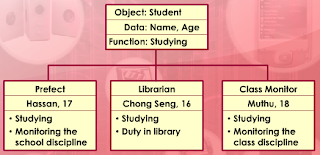STRUCTURED PROGRAMMING EDUCATION
Structured programming often uses a top-down design model where developers map out the overall program structure into separate subsections from top to bottom.
In the top-down design model, programs are drawn as rectangles. A top-down design means that the whole program is broken down into smaller sections that are known as modules.
A program may have a module or several modules.
Structured programming is beneficial for organising and coding computer programs which employ a hierarchy of modules. This means that control is passed downwards only through the hierarchy.
Examples of structured programming languages include Ada, Pascal and Fortran.
OBJECT-ORIENTED PROGRAMMING
The object-oriented approach refers to a special type of programming approach that combines data with functions to create objects.
In an object-oriented program, the object have relationships with one another.
One of the earliest OOP languages is Smalltalk. Java, Visual Basic and C++ are examples of popular OOP languages.
DIFFERENCE BETWEEN STRUCTURED AND OBJECT ORIENTED PROGRAMMING
- Structured programming often uses a top-down design model.
- The object-oriented programming approach uses objects.
__________________________________________________________________________________
Others Lesson : | click lesson to view |
- Define Program and Programming Language
- Level And Generation Of Programming Language
- Programming Language Approach
- Translator
- Basic Element In Programming : Constant And Variable
- Basic Element In Programming : Data Type
- Basic Element In Programming : Mathematical and Logical
- Basic Element In Programming : Sequence And Control
- Pseudo-code And Flowchart













0 comments:
Post a Comment